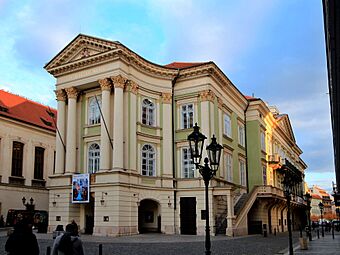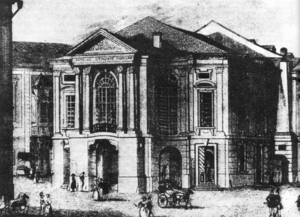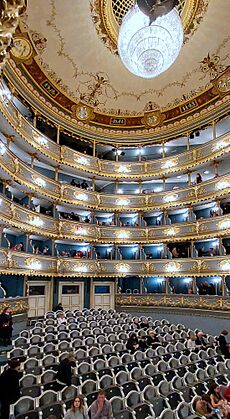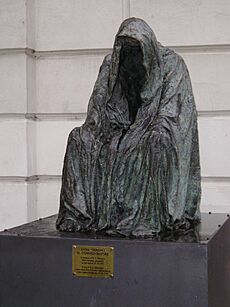Estates Theatre facts for kids
| Stavovské divadlo | |
|
|
 |
|
| Address | Prague Czech Republic |
|---|---|
| Coordinates | 50°05′10″N 14°25′26″E / 50.08611°N 14.42389°E |
| Operator | National Theatre (Prague) |
| Construction | |
| Opened | 1783 |
| Architect | Anton Haffenecker |
The Estates Theatre (called Stavovské divadlo in Czech) is a very old and famous theatre in Prague, Czech Republic. It became part of the National Theatre in 1948. Today, the theatre hosts performances by three artistic groups: opera, ballet, and drama. These groups perform at the Estates Theatre, the National Theatre, and the Kolowrat Theatre.
Contents
A Look Back: The Theatre's History
How the Estates Theatre Began
The Estates Theatre was built in the late 1700s. This was a time when people believed everyone should have a chance to experience theatre. The theatre was designed by Anton Haffenecker. It was built in less than two years for a rich family called the Nostitzes.
Before this, Prague had other theatres. The Sporck Theatre was open from 1724 to 1735. Another theatre, the "Kotzentheater," operated off and on until 1783. The Estates Theatre, then called "Nostitzsches Nationaltheater," opened in 1783. Its first show was a serious play called Emilia Galotti. This play was written by a German writer named Gotthold Ephraim Lessing.
The building itself was built in a style called Neoclassical. It still looks almost the same today as it did when it was first built. Above the main entrance, there is a motto: Patriae et Musis. This means "To the Native Land and the Muses," showing what the builder intended.
Changes Over Time: Names and Ownership
The Estates Theatre has changed its name several times. In 1798, the Bohemian Estates (a group of nobles) bought it. It was then called the Royal Theatre of the Estates.
Later, in 1862, a new theatre called the Provisional Theatre opened. The Czech acting group moved there. The Estates Theatre then focused only on German performances. It was renamed Deutsches Landestheater (Provincial German Theatre).
In 1920, the German group left. The theatre was again called the Theatre of the Estates. It also became connected with the National Theatre. In 1948, it was renamed the Tyl Theatre, after the writer J.K. Tyl. It kept this name until 1990. After eight years of repairs, it was finally called the Estates Theatre again.
Famous Shows and Artists
The theatre was first meant for German plays and Italian operas. But shows in other languages were also performed. Czech plays started in 1785 to reach more Czech people. By 1812, they were a regular part of Sunday shows. Many important Czech writers worked at the Estates Theatre. These included the Thám brothers (Karel and Václav) and J.K. Tyl.
The first modern Czech opera, The Tinker by František Škroup, was performed here in 1826. In 1834, a very important song premiered here. It was "Where is my Home?" (Kde domov můj), which later became the Czech national anthem.
International Stars at the Theatre
Many famous artists from other countries also performed at the Estates Theatre. Conductors like Carl Maria von Weber and Gustav Mahler led orchestras here. Famous actors like A.W. Iffland also performed. The opera singer Angelica Catalani and the amazing violin player Niccolò Paganini also visited.
One of the theatre's biggest claims to fame is its connection to Wolfgang Amadeus Mozart. He conducted the first-ever performance of his opera Don Giovanni here in October 1787. Also, in 1791, Mozart's La Clemenza di Tito was first shown to the public here. This was part of a celebration for the crowning of Emperor Leopold II. The Estates Theatre is the only theatre still standing where Mozart performed.
The Estates Theatre Today
Today, the Estates Theatre continues to host dramas, ballets, and operas. The opera company especially focuses on the works of Wolfgang Amadeus Mozart.
Many scenes from the movie Amadeus were filmed at the Estates Theatre. This movie is about Mozart's life. The theatre also appeared in the film Immortal Beloved, which was about the composer Beethoven.
In 2000, a statue called Il Commendatore was placed in front of the theatre. This statue was created by Anna Chromy. It was inspired by a character from Mozart's opera Don Giovanni.
See also
 In Spanish: Teatro Estatal (Praga) para niños
In Spanish: Teatro Estatal (Praga) para niños




